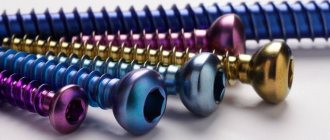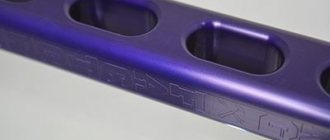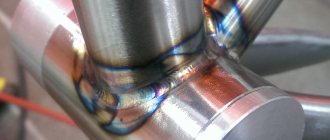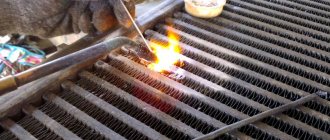It is widely known that soldering aluminum is a rather difficult and labor-intensive process. Most often, soldering of aluminum and its alloys is carried out with a gas torch at temperatures above 400°C, expensive imported solder is used, and the work itself requires specially equipped places and certain skills. These conditions significantly limit the capabilities of the end consumer.
We present the latest development - solder for low-temperature soldering of aluminum AL-220. The solder is designed for high-quality soldering of aluminum at a temperature of only 220°C, which allows you to perform soldering work with an ordinary household electric soldering iron and does not require specialized skills.
To complete the work you will need:
- household electric soldering iron
- aluminum soldering flux
- solder for low temperature soldering of aluminum
The soldering process does not differ from the usual work with tin-lead solder (POS 61). The connection prepared for soldering is cleaned of fat and oxides and a specialized “Flux for aluminum soldering” is applied. Solder is brought to the joint when the metal being soldered is heated to the solder spreading temperature. After soldering is completed, the product must be allowed to cool naturally.
Solder is available in the following diameters: 1.5 mm; 2.0mm; 3.0mm. Composition: tin, lead, zinc, cadmium. Operating temperature 220°C
- Do not solder in unventilated areas.
- Do not inhale vapors.
- Avoid contact with eyes, skin and body.
- Do not touch melted solder or hot parts of the soldering iron.
- Keep away from children.
Storage conditions: store in a dry, heated room.
There is a widespread belief that it is impossible to solder or tin aluminum (as well as alloys based on it) without special equipment for this.
Two factors are cited as an argument:
- upon contact with air, a chemically resistant and refractory oxide film (AL2O3) is formed on the surface of the aluminum part, resulting in an obstacle to the tinning process;
- The soldering process is significantly complicated by the fact that aluminum melts at a temperature of 660°C (for alloys this ranges from 500 to 640°C). In addition, the metal loses strength when, during the heating process, its temperature rises to 300°C (for alloys up to 250°C), which can cause a violation of the stability of aluminum structures.
Considering the above factors, it is truly impossible to solder aluminum using conventional means. The use of strong fluxes in combination with the use of special solders will help solve the problem. Let us consider these materials in detail.
Solder
Commonly used low-melting solder bases are tin (Sn), lead (Pb), cadmium (Cd), bismuth (Bi) and zinc (Zn). The problem is that aluminum is practically insoluble in these metals (with the exception of zinc), which makes the connection unreliable.
By using a flux with high activity and properly treating the joints, you can use tin-lead solder, but it is better to avoid such a solution. Moreover, a solder joint based on the Sn-Pb system has low corrosion resistance. Applying a paint coating to the soldering area allows you to get rid of this drawback.
For soldering aluminum parts, it is advisable to use solder based on silicon, copper, aluminum, silver or zinc. For example 34A, which consists of aluminum (66%), copper (28%) and silicon (6%), or the more common TsOP-40 (Sn - 60%, Zn - 40%).
Read also: How to remove the generator from a gas generator
Domestic solder – TsOP-40
Note that the higher the percentage of zinc in the solder, the stronger the connection and the higher its resistance to corrosion.
High-temperature solder is considered to be solder consisting of metals such as copper, silicon and aluminum. For example, like the above-mentioned domestic solder 34A, or its foreign analogue “Aluminium-13”, which contains 87% aluminum and 13% silicon, which allows soldering at temperatures from 590 to 600°C.
"Aluminum-13" produced by Chemet
When choosing a flux, it is necessary to take into account that not all of them can be active towards aluminum. We can recommend using products from a domestic manufacturer for such purposes - F-59A, F-61A, F-64, they consist of ammonium fluoroborates with the addition of triethanolamine. As a rule, the bottle is marked “for aluminum” or “for aluminum soldering.”
Domestic flux
For high-temperature soldering, you should purchase flux produced under the brand 34A. It consists of potassium chloride (50%), lithium chloride (32%), sodium fluoride (10%) and zinc chloride (8%). This composition is most optimal if high-temperature soldering is performed.
Recommended flux for packing at high temperatures
Method 1: using Zeller 480 aluminum electrode
The Zeller 480 repair electrode with 12% silicon content is designed for welding a wide range of aluminum alloys including silumin and duralumin. This method allows you to reliably weld aluminum without the use of expensive argon arc equipment.
Benefits and Applications
- If the welding process is followed, the quality of the weld made using the Zeller 480 electrode is not inferior to argon arc welding;
- High surfacing productivity;
- Dense deposited metal without pores;
- Thanks to the soft, uniform arc, the seam is even and smooth;
- Zeller 480 is the only aluminum electrode available in a “low temperature” 2mm size;
- The electrode is equipped with a special protective coating, which is highly moisture resistant, which significantly extends the service life of the electrode;
- Welding is carried out without flux, since all the necessary elements for removing the oxide film are contained in the protective coating of the electrode;
- Used for welding aluminum sheets, profiles, busbars, tanks, aluminum castings, eliminating casting defects, crankcases, car bodies, etc.
Important! Since the coating of aluminum electrodes contains hygroscopic salts, after completing all welding work, the packaging should be hermetically sealed and stored in a dry, warm place.
Instructions for use
Step 1. Before starting welding, make sure that the prepared metal sample is dry, since aluminum is hygroscopic (absorbs moisture). Using a stainless brush, clean the joints to a metallic shine and remove any remaining dirt in the area around the seam.
Step 2. If necessary, dry the electrodes for 1-1.5 hours at 100°C.
Step 3. Heat the aluminum sample to a temperature of 150-200°C using a burner.
Important! Welding cannot be carried out without heating!
Step 4. Welding is carried out using direct current of reverse polarity. The most vertical position of the electrode while maintaining a short arc. The electrode should be fed into the fusion zone quickly, moving forward as much as possible and maintaining a very short arc.
Step 5: Weld one layer in one pass.
Be careful! The welding speed is the same as that of semi-automatic welding.
The tensile strength of the weld is 200 newtons per square millimeter, which is close to the tensile strength of the base metal. Therefore, this welding method can be used on critical structures.
Surface preparation
Before you begin tinning, you must complete the following steps:
- degrease the surface using acetone, gasoline or any other solvent;
- remove the oxide film from the place where soldering will be performed. For cleaning, use sandpaper, an abrasive wheel or a brush with steel wire bristles. As an alternative, etching can be used, but this procedure is not so common due to its specificity.
It should be taken into account that it will not be possible to completely remove the oxide film, since a new formation will immediately appear in the cleaned area. Therefore, stripping is carried out not with the goal of completely removing the film, but to reduce its thickness in order to simplify the task of the flux.
Heating the soldering area
To solder small parts, you can use a soldering iron with a power of at least 100W. Massive items will require a more powerful heating tool.
Soldering iron 300 Watt
The best option for heating is to use a gas burner or blowtorch.
Simple gas burner
When using a burner as a heating tool, the following nuances should be taken into account:
- Do not overheat the base metal, as it may melt. Therefore, it is necessary to regularly monitor the temperature during the process. This can be done by touching the solder to the heated element. Melting the solder will let you know that the required temperature has been reached;
- Oxygen should not be used to enrich the gas mixture, since it promotes strong oxidation of the metal surface.
Preparation of aluminum parts for welding
Due to the specific properties of aluminum, its preparation before welding is of key importance to the final result.
Particular attention should be paid to the location (edges of the product) for the planned weld. Mainly cleaning is performed in order to get rid of the oxide film.
Sequence of preparation:
- Cleaning and degreasing the material from plaque of any origin . This is done with acetone, solvent, or, less commonly, aviation gasoline.
- Cutting edges is necessary if their thickness exceeds 4 mm when using standard electrodes.
- Removing the oxide film . The tool is selected according to the thickness of the aluminum part. Usually a file, milling cutter or metal brush is used.
Soldering instructions
The process of soldering aluminum parts does not have its own distinctive features; it is carried out in the same way as with steel or copper.
The algorithm of actions is as follows:
- the soldering area is degreased and cleaned;
- the parts are fixed in the desired position;
- the connection area heats up;
- touch the solder rod (containing active flux) to the joint. If flux-free solder is used, then flux is applied to destroy the oxide film, after which a solid piece of solder is rubbed over the soldering area.
A brush with steel wire bristles is also used to break down the aluminum oxide film. This simple tool is used to rub molten solder over an aluminum surface.
Soldering aluminum - complete video instructions https://www.youtube.com/watch?v=ESFInizLE9U
What to do if you don’t have the necessary materials?
Read also: Comparator on lm358 circuit
When it is not possible to prepare all the materials necessary for soldering, you can use an alternative method that uses tin or tin-lead solder. As for the flux, it is replaced by rosin. To prevent the formation of a new aluminum oxide film in place of the old one, stripping is carried out under a layer of molten rosin.
The soldering iron, in addition to its direct purpose, will be used as a tool that destroys the oxide film. To do this, a special scraper is put on its sting. You can increase the effectiveness of the process by adding metal filings to the rosin.
The process is carried out as follows:
- use a heated tinned soldering iron to melt the rosin at the soldering site;
- When the rosin completely covers the surface, they begin to rub it with a soldering iron tip. As a result, metal filings and stings destroy the aluminum oxide film. Since the layer of molten rosin does not allow air to penetrate to the aluminum surface, an oxide film does not form on it. As the film is destroyed, tinning of the part will occur;
- When the tinning process is completed, the parts are joined and heated until the melting temperature of the solder is reached.
It must be warned that the process of soldering aluminum without special materials is a rather troublesome process with no guarantee of successful completion. Therefore, it is better not to waste your time and energy on such work, especially since the quality and reliability of such a connection will be questionable.
It is much easier to buy active flux and high-temperature solder, with which soldering aluminum even at home will not cause difficulties.
Aluminum is a chemical element with strongly pronounced metallic properties. When exposed to oxygen from the surrounding air, it easily oxidizes, forming a dull, gray oxide coating.
This is what aluminum products look like. If the surface is cleaned, a metallic sheen of the pure substance can be observed within a few minutes. A dense, refractory coating of oxides significantly complicates any work with metal.
It is believed that soldering aluminum products is very difficult. This doesn't always happen. A good aluminum solder makes things easier. The composition of the compositions makes it possible to cope with the oxide layer and ensure the formation of a seam.
How to solder aluminum
Until recently, I didn't know how easy it was to solder aluminum with a propane torch. The torch I use has a wide flame, so it's probably not as effective at heating up a specific area to weld. A torch with more points will be better. Either way, if you have a propane torch and soldering rods, you can weld aluminum. These can all be found at your local hardware store.
Step 1: Buy the Right Aluminum Soldering Rod
In the same place where everything is designed for arc welding, you will find aluminum brazing. My rod has an operating temperature of 370 to 400 degrees Celsius. A propane torch burns hot enough to get the job done.
Step 2: Clean the parts at the joint
Any time metal is fused, it is always best that you clean it. I use a wire brush on both surfaces. Now the parts are ready for the heat.
Step 3: Soldering Aluminum
Apply the flame to the joint until it is hot enough to melt the rod. When you swipe the tip of the rod, it should melt. If not, heat the joint again and check it. You want the metal to melt the rod, not the flame. Once everything has cooled, you will have a strong connection. Look at the last picture where I tried to break the connection in a vice. The metal bent before the rupture occurred. Source
What is the problem
The oxide film melts at a very high temperature. Its presence prevents the penetration of the solder melt into the base metal and disrupts the wetting of the soldering area.
Aluminum has a low melting point. It completely turns into a liquid state at 660℃. A change in the state of aggregation begins at a temperature of about 300 ℃. Most aluminum alloys contain metals that melt at as low as 500℃.
When high-temperature soldering, it is very easy to “overshoot” the small heating interval, which allows you to obtain a normal seam.
There is a high probability of overheating of the melting zone, as a result of which fragments of parts will turn into a liquid state. It should be remembered that soldering must be carried out by enveloping solid working areas of products with a molten mass of solder.
Welding aluminum using fluxes
Fluxes for welding aluminum have been used for a long time. They are represented by a wide range of models, where there are materials for different aluminum alloys. Their main purpose is to destroy the oxide film. When heated, the applied flux dissolves and destroys the oxide, and the two elements are immediately connected.
Manufacturers offer fluxes that are used only in gas welding of aluminum, or only in arc welding. In the latter case, graphite or carbon electrodes are used.
Materials with tin
There are many metal compositions for soldering aluminum products.
The composition of most low-melting solders is dominated by copper, tin, and lead; cadmium, bismuth, and indium are present.
However, aluminum does not dissolve very well in these metals, which causes reduced strength of the seams formed during soldering.
An additional difficulty is created by the low corrosion resistance of solders made of tin and lead. When working with these compounds, the soldered aluminum joint is coated with paint and varnish protective agents.
Soldering using solders with the following metals gives good results:
Read also: The gear ratio of chain drives usually does not exceed
There are many compositions containing these metals in varying proportions. Domestic craftsmen are primarily interested in Russian products (rods and wire), which have good quality and an affordable price.
A popular solder is 60% tin and 40% zinc. It is known that an increased zinc content gives the weld corrosion resistance.
Special requirements
The mechanical characteristics of the wire used for aluminum welding force certain requirements to be placed on the design of semi-automatic machines and their operation.
- It is unacceptable that the length of the supply hose exceeds three meters, and its protective braiding is prone to twisting or kinking. It is important that the channel through which the wire passes is as smooth as possible, without sharp turns. It is optimal if the supply channel itself is made of Teflon.
- The feed mechanism must pull the wire without jerking, providing minimal mechanical impact on its surface. Its components should be inspected promptly for damage and lubricated frequently to ensure free rotation of the rollers.
- The best results can be obtained with equipment whose design provides for the possibility of smooth and precise adjustment of all parameters. Everything is important - the current strength, the speed at which the wire is fed, the amount of incoming gas. Since the influence of the external environment can affect the quality of the weld during its formation, stopping the gas supply should not occur simultaneously with turning off the current, but with a delay of about 5 - 7 seconds.
Semi-automatic welding of aluminum requires certain skills and craftsmanship from the specialist involved in it. And although watching a video of how professionals work is not a problem, you should not follow their recommendations recklessly. This information is best used as a starting point from which you can experiment and gain experience yourself. This is important because materials that differ in composition and thickness behave differently, as do semi-automatic devices produced by different manufacturers.
Kastolin
Imported castolin consists only of aluminum and zinc. It has good fluidity, penetrating ability, and electrical conductivity.
Some inconvenience is caused by the impossibility of using this solder for parts with a magnesium content of more than 1.5% and products that are subsequently planned to be anodized.
Castolin sells a range of solders with a varied combination of components. After consultation, you can choose a remedy for specific conditions.
Aluminum alloys with additives
High-temperature solder containing 66% pure aluminum, 28% copper and 6% silicon is effective for soldering. It was made in Russia. A significant concentration of the base metal, identical to the material of the working parts, increases solubility and penetration of the melt.
The base of the weld, which includes copper and aluminum, is strengthened by the presence of silicon. The connection formed using aluminum solder does not corrode and has good mechanical properties.
The addition of silicon increases the melting point of solders. Thus, a composition of 87% aluminum and 13% silicon melts at temperatures of about 600 ℃. This type of imported product goes on sale ready for use. Solder with flux is more expensive. The increased price is compensated by the high quality of the seam.
An American composite of 9 components gives excellent soldering results. The rods melt at a temperature of 347 ℃, increasing in volume by 10%. The resulting seam is distinguished by its ductility, which is 3 times higher than that of joints made from other alloys.
High-temperature soldering is carried out when working with massive parts made of aluminum or products made of alloys that melt only under strong heat. Heating is provided by gas burners operating on pure hydrocarbons or their mixtures with oxygen. You can use a regular soldering iron.
Which inverter is suitable for aluminum welding
The choice of inverter for aluminum welding depends on the volume and complexity of the work. If you have to do repairs infrequently, and there are no high demands on the quality of the connection, a cheap device is enough. Otherwise, preference is given to a model with MMA and TIG functions. This device makes connections using coated electrodes and argon arc welding. For home repairs, a current of 200 A is sufficient.
To simplify and speed up work at large volumes, you should pay attention to inverters with an oscillator that allows you to ignite the arc in a non-contact manner. The option of gradual arc decay, polarity balance control and pulse mode will be useful. If the inverter is expected to be moved frequently, preference should be given to compact models. They are more expensive than devices with similar functions, but are more convenient for transportation.
Selection of fluxes
Taking into account the specifics of soldering aluminum parts, the choice of fluxes must be approached carefully.
There are domestic products consisting of several components. They provide effective cleaning of parts and prevent oxidative processes when heated. This is especially true when using tin and lead solders, which are known to be susceptible to oxidation.
Good penetrating ability is provided by a multicomponent flux made from ammonium and zinc fluoroborates, triethanolamine, and additives. The product has an affordable price. Its effectiveness has been tested many times in practice.
A well-known high-temperature flux consists of potassium, lithium and zinc chlorides; sodium fluoride. The dry mixture is poured into the soldering work area on a stick, waiting for uniform melting and mixing with the solder mass.











